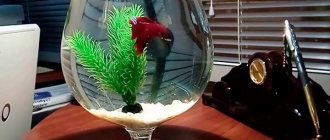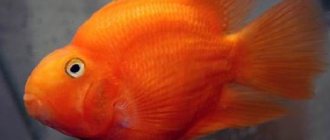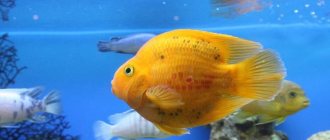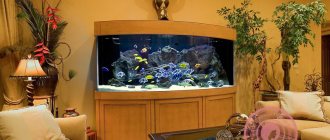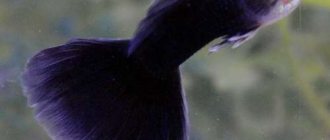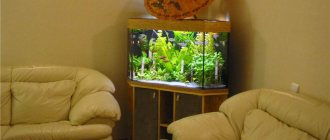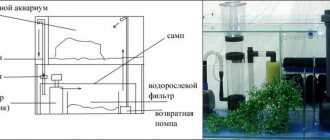Quickly navigate to the article
- 1 Features and advantages of aquarium glass
- 2 Settling the aquarium
- 3 Decoration of the aquarium
- 4 Aquarium care 4.1 Other interesting articles
An aquarium in the form of a glass is often given as a gift to beginning aquarists. Thanks to its unusual shape, the pond looks good in any room and perfectly complements the interior. The aquarium glass is compact and does not require much space, as it easily fits on a table, shelves or bedside tables. This quality is both an advantage and a disadvantage - due to its small size, you cannot keep a lot of fish and decorations in the reservoir.
Advantages and disadvantages
Aquariums with legs are popular among office workers. Such a decorative living pond can be placed directly on your desktop. And at home, children will especially enjoy watching a beautiful fish in a small vessel.
Such an aquarium has the following advantages:
- The container is practical, as it is usually made from environmentally friendly plastic.
- Small amounts of water are easier to change.
- The shape and light weight do not interfere with moving from one place to another.
- You can find a place even in a small apartment.
- The child will be able to take care of the small dimensions independently.
- The design of such an aquarium will harmoniously fit into any interior.
Arranging and caring for a spherical vessel with aquatic inhabitants has its own difficulties, which can be avoided in an aquarium of a regular shape.
Disadvantages of a glass-shaped aquarium:
- The movement of fish is limited, since the height of the product is greater than the width.
- The number of species of aquatic inhabitants that can survive in “glass” conditions is very small.
- The spherical shape distorts the image, which affects the well-being of the fish.
- Not all plant varieties are suitable for such conditions.
- The filter gets dirty faster than if installed in a large space.
It is necessary to think about how to maintain the temperature. The lamp overheats the water greatly and cools quickly in a cold room.
Some tips
One of the vagaries of cockerels is their love for warm water. Therefore, it is advisable to place his water house near heating devices, radiators, etc.
The fish does not like drafts and excessive turmoil. She is her own boss and commander. The beauty of its fins often captivates the cockerel, making them not notice problems with digestion. At the same time, it is precisely such troubles that you should be prepared for.
Organizing the nutrition of a betta is an important issue that requires a special approach: do not overfeed, give food at a certain time, enrich the diet with useful substances. At the same time, an aquarium glass is a place where food debris will quickly rot and pollute the water. They should be collected while they are floating on the surface, immediately after 10 minutes of giving food.
Despite the cockerel’s unpretentiousness to its living conditions, its small house should be washed regularly and thoroughly. It is advisable to change the water at least once every two weeks, washing the pebbles and plants, clearing the walls of growth, mucus and yellow plaque. It is useful to carry out preventive treatment once a month with antiseptic agents intended for aquarium use. This removes the odor and prevents the growth of bacteria for some time.
It is better when the betta fish is introduced into the aquarium at a young and even “childish” age. Then she develops appropriate habits, reflexes are strengthened and she does not feel lonely.
An aquarium with a cockerel fish is a beautiful and stylish design element that gives the home softness and comfort, and the office a comfortable microclimate. It’s worth a try: the cheerful disposition of its inhabitant will bring a lot of positive emotions and fill you with optimism.
Post Views: 35,965
Arrangement of the aquarium
Arranging an aquarium in the form of a glass must be approached responsibly, since we are talking about a small and not entirely comfortable space for fish. Therefore, it is necessary to minimize the harm of a spherical shape.
Decor
Aquariums are decorated in a minimalist style. You can put some soil on the bottom and add a small amount of algae. You can get by with artificial plants rather than live ones to avoid the growth of bacteria. LED lighting looks great. At night, this underwater world looks amazing. You should not clutter the space with a lot of decorations that will limit the movement of the fish. In a glass, the main decorative role belongs to its inhabitants.
Equipment
Equipment that can be placed in such a container without compromising aesthetics and fish is more difficult to select. More often they make do with a minimum of equipment.
The following devices are required:
- lamps;
- filter;
- heater;
- compressor.
The power is selected depending on the type of inhabitants and the volume of the aquarium. When purchasing, it is necessary to focus the seller’s attention on the fact that the equipment is being purchased for a very small reservoir. It is better to do without devices at all than to connect ones that do not match the power.
Containers in the form of wine glasses are complemented with a lid to prevent fish from jumping out and to protect from debris and various objects. The cover is used as a platform for fixing equipment and will protect against attacks by other pets.
Plants
Even in aquariums of 5-15 liters you can place green spaces that will grow without additional carbon dioxide and even without soil. It should be remembered that plants need light in all conditions. It is necessary to ensure that they do not rot or grow. For plants that need soil, a layer of 3 cm is arranged. This is enough for the root system. The soil is pressed down with pebbles, preferably black ones.
Algae that can be planted in a miniature pond:
- Anubias are beautiful, not tall. There is no need to plant it in the ground, just tie it to a pebble at the bottom. The roots will sprout on their own where they need to. The growing season of algae is slow, so it will not be difficult to ensure that they do not fill the bowl.
- Hornwort absorbs the organic matter necessary for life directly from the water. An unpretentious underwater plant that survives in extreme conditions. It is recommended to press down the lower part with a stone or sprinkle it with soil. The only inconvenience is that the extra branches need to be plucked off from time to time.
Plants that live on the surface of the water should not be planted in a container that tapers towards the top. The area of contact with the air is already limited.
How to “get out of the situation”?
In such cramped conditions, it is hardly possible to grow a variety of flora, except maybe one or two pots with bush varieties. Layer-by-layer planting of plants in the soil is unrealistic due to its insignificant quantity and problems with sanitation. If you take the risk of placing natural stones or sand, you can quickly face the problem of their silting, turbidity and colonization by bacteria. This also happens due to a lack of oxygen and the low self-purifying ability of a small volume of water.
It is rational to decorate an aquarium for a betta with artificial algae, choosing bushy and spreading options. One of their advantages is that they are equipped with a weight that makes the presence of soil optional.
Even if soil becomes optional for such “plants,” they should complete the underwater ensemble for beauty and originality. Transparent glass pebbles shimmering in different colors are the best option. They “play” beautifully in the light and even visually increase the available volume; they are easy to clean and disinfect.
And finally, decorative elements. It is better not to choose large and tall ones. You need a discreet and stylish design that does not distract the main attention from the living occupant.
An aquarium glass can be made of either natural glass or special plastic. The main requirements for it:
- practicality;
- strength;
- environmental Safety;
- transparency;
- ease of hygienic care.
Aquarium fish
The glass aquarium is suitable for bright fish that can live in a limited spherical space:
- You can introduce a small catfish, which will happily clean the green coating from the walls.
- Neons will feel comfortable and will decorate an unusual glass. The only problem is that you can’t admire it from afar.
- Guppies will not feel cramped, but they have the peculiarity of reproducing quickly. You will have to provide a container for placing the fry.
- The betta fish is an ideal option for an aquarium in the form of a glass. For comfort, he needs warmth and bright light. If there is not enough oxygen, it captures it by swimming to the surface.
Attention! Beginning aquarists make the mistake of choosing a goldfish to add to a glass. This is absolutely impossible to do. Goldfish need space and plenty of algae. If you want to watch the life of a beautiful fish in a glass on your desktop, it’s better to stick with a cockerel.
What are they?
Fish in a glass is original and modern. Professional aquarists do not regard this option as biologically feasible. It is impossible to create conditions for self-purification of water, plant living plants and select natural soil. Devices that maintain the required water quality (aerator, pump, filter, heater, thermometer, etc.) will also remain unclaimed.
That is why the choice of a resident in such a house is small. The fish should not need ideal conditions; it is better if it adapts to limited space and oxygen deficiency. This option is the cockerel - a biological species capable of swallowing oxygen from the air, floating to the surface to do this. Her character is labyrinthine, she loves warmth, light and thickets. With a betta fish there will be no big problems regarding the purity of the water and the lack of oxygen in it.
The rounded shape of such an aquarium entails:
- narrowed bottom and, accordingly, insufficient amount of soil for plant rooting;
- a vertical column of water exceeding its width in height;
- distortion of the parts placed inside due to the spherical shape of the walls.
Aquarium care
A spherical aquarium requires constant maintenance. It is necessary to have a fish net, paper napkins, and a magnetic scraper on hand. Using a biological filter will make caring for a spectacular pond easier.
Rules of care:
- The water must be changed frequently, once every 7-10 days. 20% of the water must be replaced. Tap water is pre-settled.
- During cleaning, the fish are moved to another container, otherwise they can easily be harmed.
- You cannot catch fish with your hand or a glass, only with a net.
- Clean glass walls using magnetic scrapers.
- Decorative elements are disinfected using boiling or baking soda. Detergents cannot be used.
- Organic matter is removed from the soil using a siphon.
If you take good care of your glass in a timely manner, such a pond will bring joy to adults and children and will decorate the interior of your home or office. If you liked the article, leave comments and share a link to it on social networks.
Some fish for glasses:
• guppies are the best species for a glass aquarium;
• one fish survives in an aquarium with a volume of 9-10 liters at a temperature of 26°C;
• goldfish are not the best fish for aquariums. She produces a lot of waste and grows big. Goldfish are kept in an 18-liter or larger reservoir, be sure to change 25-50% of the water every 3-4 days;
• barbs; • minnows; • paradise fish; • zebrafish; • corridors.
In addition to the fish species listed above, certain species of small shrimp and sea monkey crustaceans survive in a small glass aquarium. In addition, they use a high-quality aquarium glass for an ecosystem of aquatic plants or to simulate the bottom of the sea without fish.
